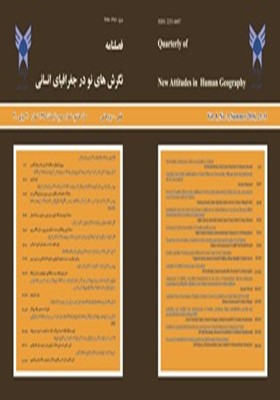ضرورت توسعه پایدار در مناطق عشایری استان فارس
محورهای موضوعی : کالبدیعلی شکور 1 , علی شمس الدینی 2 , اعظم حیدری 3 , غلامعباس واحدپور 4
1 - دانشیار جغرافیا و برنامهریزی روستایی، واحد مرودشت، دانشگاه آزاد اسلامی، مرودشت، ایران
2 - استادیار جغرافیا و برنامهریزی روستایی، واحد مرودشت، دانشگاه آزاد اسلامی، مرودشت، ایران
3 - کارشناسی ارشد ژئومورفولوژی و برنامهریزی محیطی، دانشگاه محقق اردبیلی، اردبیل، ایران
4 - عضو هیات علمی جغرافیا، واحد لارستان، دانشگاه آزاد اسلامی، لارستان، ایران
کلید واژه:
چکیده مقاله :
چکیده توسعه پایدار جامعه عشایری، فرآیندی است که در آن سیاستهای طبیعی، اجتماعی، اقتصادی، کالبدی و مدیریتی و دیگر سیاستها چنان طراحی شده باشند که از نظر اقتصادی، اجتماعی و بوم شناسی پایدار باشد. جامعه عشایری به عنوان جامعه سوم در کنار سایر جوامع (شهری - روستایی) در ایران به جامعهای اطلاق میشود که معیشت مبتنی بر دامداری، و استفاده از مراتع میباشد. بنابر این بررسی توسعه پایدار در جامعه عشایری استان فارس حائز اهمیت فراوانی است. این پژوهش در این راستا از جامعه آماری منطقه مورد نظر با استفاده از فرمول کوکران تعداد 60 نمونه(نفر) انتخاب گردید. ابزار تحقیق پرسشنامه بوده و روش جمعآوری اطلاعات با استفاده از تکنیکهای مشاهده و مصاحبه انجام گرفت. میزان ضریب آلفای کرونباخ برای ساختار اقتصادی 88/0 بدست آمده و با استفاده از نرم افزار (19 (SPSSمیزان همبستگی ساختار اقتصادی از طریق آزمون پیرسون با فاکتورهایی مانند تعداد دامهای عشایر، میزان درآمد سالانه از دامداری و سابقه بهره برداران مورد تجزیه و تحلیل قرار گرفته است. نتایج بدست آمده بین میزان ساختار اقتصادی با میزان درآمد سالانه از دامداری و سابقه بهره برداران رابطه مستقیم معنی دار و با تعداد دام رابطه عکس معنی داری وجود دارد و نشاندهنده رابطه تنگاتنگ جامعه عشایری با ساختار اقتصادی آنها است. از جمله نتایج حاکی از ضعف اقتصادی بهرهبرداریهای عشایری، بهران مدیریت و تخریب ناشی از چرای مفرط، افزایش هزینههای تعلیف دستی دام، نگرش منفی به روند زندگی آتی عشایر، عدم حمایت کافی از بیمه عشایر توسط دولت، نبود بازار مشخص خرید و فروش دام، مهاجرت فصلی جوانان عشایر به شهرها برای تأمین هزینههای زندگی به دلیل ناکافی بودن درآمد، همچنین جامعه عشایر مورد مطالعه تحت نظام ایلی توان پتانسیل توسعه خود را به دلیل محدودیتهای جمعیتی( اکولوژیکی) اقتصادی- اجتماعی- فرهنگی را تا حدودی از دست داده است و اقتصاد عشایر مورد مطالعه دارای ضعفهای اساسی میباشد. بنابر این ترسیم افق آتی و داشتن برنامه بلند مدت و میان مدت برای این جامعه میتواند در توسعه پایدار جامعه عشایری کشور مؤثر واقع گردد.
References
Amanullahi, B. (2003): "decline in Iranian nomadic and sedentary tribes of nomads' national studies, Issue I (row 17). Pages 53.
Anjam rooz, S. (2006), "theoretical independence of the nomads in the mountain valley of Jiroft", Journal of Archaeological Research, Issue XVI, pp. 61.
Bashiri, A. and Babai, M. (2012): "tribal councils promotion of development", National Conference tribes, order and security, Ardabil, Volume I, Ss86- 82.
Bahrami, A, et al. (2012): "Analysis of the effects of drought on livelihood security and tribal Bardsir city", the first national conference of tribal and order and security, the first volume.
Khaki Pour, L. et al. (2010): "The level of farm income ranges tribal families Homian Basin Case Study", Ss437-430.
Dygar, Jean-Pierre. (2003): Il-populated areas of sustainable development, publication of a man, Number Six, Ss147- 176.
Rahimi, S, and Sadeghi, S. (2004): "calculate and analyze the factors affecting the performance of assigned management plans (private pasture), Journal of Agricultural Economics and Development, Special productivity and efficiency
Zahedi, sh. and Ibrahim Poor, H. (2011): governance based on sustainability (with an emphasis on environmental protection), the publisher, Tehran.
The tribal affairs, years (84 in 2003).
Management Planning Country (2003).
Shateri, M. and hajipoor, M. (2010): new approaches in human society Quarterly, Issue II, Ss17-1. second year (2).
Shakoor, A. and Rezaei, M. (2009): "Evaluation and comparing the production in Firovzabad measure and its tendency to change livelihood," Journal of innovative approaches in human geography,
Seydai, S, A. (1997): Iranian nomadic community sustainable development in the future, Journal of Literature and Languages, pp. 100- 83.
Ali poor, L. and Eisaei, H. (2010): Market nomadic multi-functional: a step sustainability of life of nomads, 1 (14), Ss149-172.
Fayyaz, M. (2005): "An over view of the history of planning in the rangelands of Iran research", congress and festival pasture and rangeland, Khorasan.
Ghanbari, A. (1887): Productivity in nomadic tribes, thesis MA in Economics, University of Shiraz.
Mohebi, A. (2012): "Analysis of the major problems of Nomads", the first national conference of tribal, order and security, Ardabil, first year, first issue, Ss119-15.
Statistical Center of Iran, the detailed results of social and economic census of nomads, Salhay66-77-1387, press the Statistical Center of Iran.
Moshiri, R. (2000): Nomadic Foundations and Iran, the publisher, Fifth Edition, Tehran.
Mansouri, M. (2001): "Comparison of production in the fields of economy, nomadic groups and their tendency to change in the mode of production Jalali tribe northwest tribal Case Study," Journal of Social Sciences, Shiraz University, 19 (1 ), Ss72-60.

